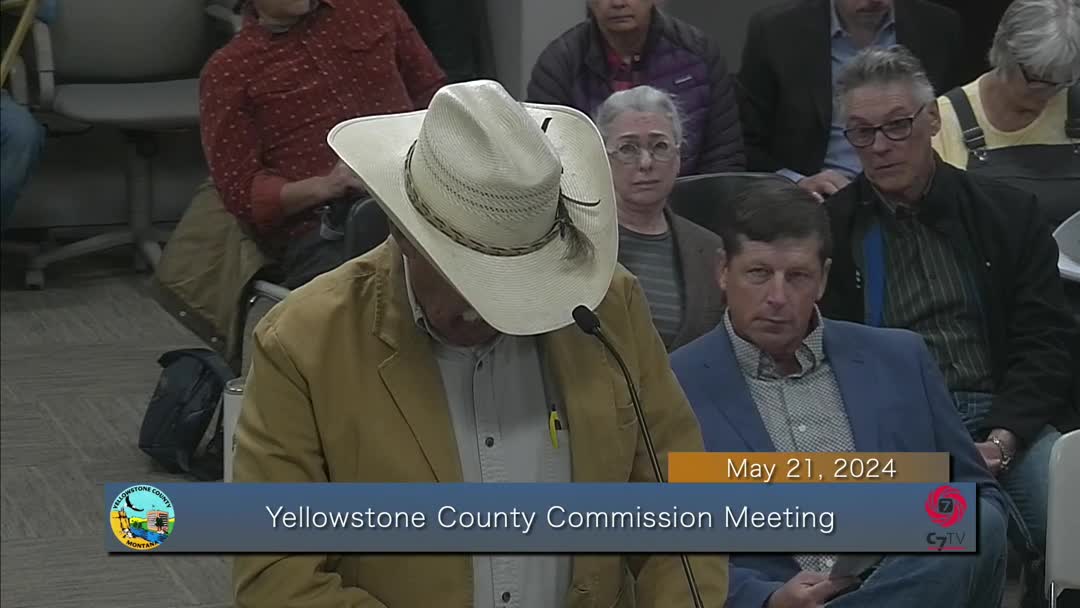Yellowstone County Residents Urge Commissioners to Keep Agricultural Zoning Near Laurel
May 21, 2024 | Yellowstone, Montana

This article was created by AI summarizing key points discussed. AI makes mistakes, so for full details and context, please refer to the video of the full meeting. Please report any errors so we can fix them. Report an error »

During the Yellowstone County Commissioner Meeting on May 21, 2024, significant discussions centered around zoning issues and community concerns regarding potential industrial developments near residential areas. The meeting highlighted the ongoing tension between agricultural land use and the push for industrial zoning, particularly in the vicinity of Laurel.
One of the key testimonies came from Michelle Kelly, a resident of Laurel, who expressed her strong opposition to any rezoning of agricultural land west of her property. Kelly emphasized that this land has historically been used for agriculture and is classified as prime farmland. She argued that any shift towards industrial zoning would not only disrupt the rural character of the community but also negatively impact property values and the quality of life for residents. Kelly's concerns included increased pollution, noise, and traffic, which she believes would arise from industrial activities.
Another resident, Steve Crum, raised legal concerns regarding the county's authority to enact jurisdictional zoning in the area. He pointed out that the necessary growth policy for the region has not been adopted, which he argued is a prerequisite for such zoning changes under Montana law. Crum stressed that the county should not proceed with zoning changes until proper procedures are followed, including obtaining consent from a majority of property owners in the proposed area.
The discussions reflect a broader community apprehension about the balance between development and preserving the agricultural landscape that many residents value. The testimonies underscored a desire for the county commissioners to prioritize the interests of existing residents over industrial expansion.
As the meeting concluded, the commissioners were left to consider the implications of these testimonies and the legal framework surrounding zoning decisions. The outcome of this meeting could significantly influence the future development of the area, as residents continue to advocate for maintaining the agricultural zoning that has defined their community. The next steps will likely involve further discussions on zoning policies and community engagement to address the concerns raised by residents.
One of the key testimonies came from Michelle Kelly, a resident of Laurel, who expressed her strong opposition to any rezoning of agricultural land west of her property. Kelly emphasized that this land has historically been used for agriculture and is classified as prime farmland. She argued that any shift towards industrial zoning would not only disrupt the rural character of the community but also negatively impact property values and the quality of life for residents. Kelly's concerns included increased pollution, noise, and traffic, which she believes would arise from industrial activities.
Another resident, Steve Crum, raised legal concerns regarding the county's authority to enact jurisdictional zoning in the area. He pointed out that the necessary growth policy for the region has not been adopted, which he argued is a prerequisite for such zoning changes under Montana law. Crum stressed that the county should not proceed with zoning changes until proper procedures are followed, including obtaining consent from a majority of property owners in the proposed area.
The discussions reflect a broader community apprehension about the balance between development and preserving the agricultural landscape that many residents value. The testimonies underscored a desire for the county commissioners to prioritize the interests of existing residents over industrial expansion.
As the meeting concluded, the commissioners were left to consider the implications of these testimonies and the legal framework surrounding zoning decisions. The outcome of this meeting could significantly influence the future development of the area, as residents continue to advocate for maintaining the agricultural zoning that has defined their community. The next steps will likely involve further discussions on zoning policies and community engagement to address the concerns raised by residents.
View full meeting
This article is based on a recent meeting—watch the full video and explore the complete transcript for deeper insights into the discussion.
View full meeting
